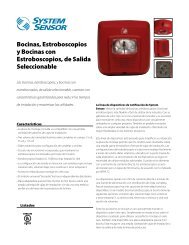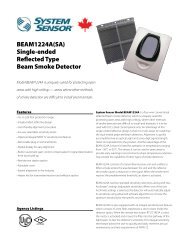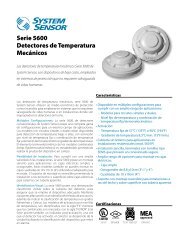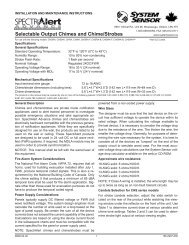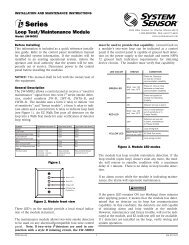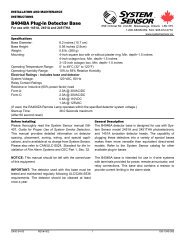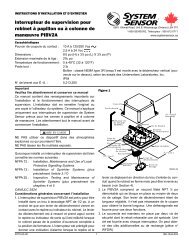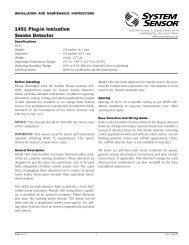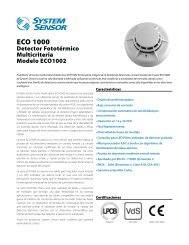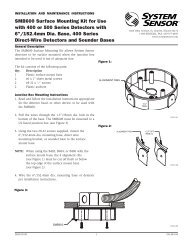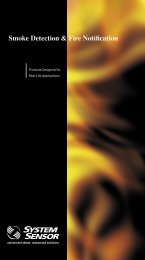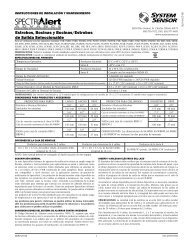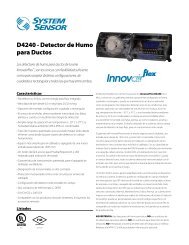DH100ACDCLPX Air Duct Smoke Detector with Extended Air Speed ...
DH100ACDCLPX Air Duct Smoke Detector with Extended Air Speed ...
DH100ACDCLPX Air Duct Smoke Detector with Extended Air Speed ...
Create successful ePaper yourself
Turn your PDF publications into a flip-book with our unique Google optimized e-Paper software.
Limitations of Fire Alarm Systems<br />
Manufacturer recommends that smoke and/or heat detectors be located<br />
throughout a protected premise following the recommendations of<br />
the current edition of the National Fire Protection Association Standard<br />
72, National Fire Alarm Code (NFPA 72), manufacturer’s recommendations,<br />
state and local codes, and the recommendations contained in<br />
Guide for the Proper Use of System <strong>Smoke</strong> <strong>Detector</strong>s, which is made<br />
available at no charge to all installing dealers. A study by the Federal<br />
Emergency Management Agency (an agency of the United States government)<br />
indicated that smoke detectors may not go off or give early<br />
warning in as many as 35% of all fires. While fire alarm systems are<br />
designed to provide warning against fire, they do not guarantee warning<br />
or protection against fire. Any alarm system is subject to compromise<br />
or failure to warn for a variety of reasons. For example:<br />
• Particles of combustion or “smoke” from a developing fire may<br />
not reach the sensing chambers of the smoke detector because:<br />
- Barriers such as closed or partially closed doors, walls, or<br />
chimneys may inhibit flow.<br />
- <strong>Smoke</strong> particles may become “cold” and stratify, and may<br />
not reach the ceiling or upper walls where detectors are located.<br />
- <strong>Smoke</strong> particles may be blown away from detectors by air outlets.<br />
- <strong>Smoke</strong> particles may be drawn into air returns before reaching<br />
the detector.<br />
In general, smoke detectors on one level of a structure cannot be<br />
expected to sense fires developing on another level.<br />
• The amount of “smoke” present may be insufficient to alarm<br />
smoke detectors. <strong>Smoke</strong> detectors are designed to alarm at<br />
various levels of smoke density. If such density levels are not<br />
created by a developing fire at the location of detectors, the<br />
detectors will not go into alarm.<br />
• <strong>Smoke</strong> detectors, even when working properly, have sensing<br />
limitations. <strong>Detector</strong>s that have photoelectronic sensing chambers<br />
tend to detect smoldering fires better than flaming fires,<br />
which have little visible smoke. <strong>Detector</strong>s that have ionizingtype<br />
sensing chambers tend to detect fast flaming fires better<br />
than smoldering fires. Because fires develop in different ways<br />
and are often unpredictable in their growth, neither type of<br />
detector is necessarily best and a given type of detector may not<br />
provide adequate warning of a fire.<br />
• <strong>Smoke</strong> detectors are subject to false alarms and nuisance alarms.<br />
For example, a smoke detector located in or near a kitchen may<br />
go into nuisance alarm during normal operation of kitchen appliances.<br />
In addition, dusty or steamy environments may cause a<br />
smoke detector to falsely alarm. If the location of a smoke detector<br />
causes an abundance of false alarms or nuisance alarms, do<br />
not disconnect the smoke detector; call a professional to analyze<br />
the situation and recommend a solution.<br />
• <strong>Smoke</strong> detectors cannot be expected to provide adequate warning<br />
of fires caused by arson, children playing <strong>with</strong> matches<br />
(especially <strong>with</strong>in bedrooms), smoking in bed, violent explosions<br />
(caused by escaping gas, improper storage of flammable<br />
materials, etc.).<br />
• Heat detectors do not sense particles of combustion and are designed<br />
to alarm only when heat on their sensors increase at a<br />
predetermined rate or reaches a predetermined level. Heat detectors<br />
are designed to protect property, not life.<br />
• Warning devices (including horns, sirens, and bells) may not<br />
alert people or wake up sleepers who are located on the other<br />
side of closed or partially open doors. A warning device that<br />
activates on a different floor or level of a dwelling or structure is<br />
less likely to awaken or alert people. Even persons who are<br />
awake may not notice the warning if the alarm is muffled by<br />
noise from a stereo, radio, air conditioner or other appliance, or<br />
by passing traffic. Audible warning devices may not alert the<br />
hearing-impaired (strobes or other devices should be provided to<br />
warn these people). Any warning device may fail to alert people<br />
<strong>with</strong> a disability, deep sleepers, people who have recently used<br />
alcohol or drugs, or people on medication or sleeping pills.<br />
- Please note that:<br />
i) Strobes can, under certain circumstances, cause seizures<br />
in people <strong>with</strong> conditions such as epilepsy.<br />
ii) Studies have shown that certain people, even when they<br />
hear a fire alarm signal, do not respond or comprehend<br />
the meaning of the signal. It is the property owner’s responsibility<br />
to conduct fire drills and other training exercises<br />
to make people aware of fire alarm signals and instruct<br />
on the proper reaction to alarm signals.<br />
iii) In rare instances, the sounding of a warning device can<br />
cause temporary or permanent hearing loss.<br />
• Telephone lines needed to transmit alarm signals from a premises<br />
to a central station may be out of service or temporarily out<br />
of service. For added protection against telephone line failure,<br />
backup radio transmission systems are recommended.<br />
• System components, though designed to last many years, can<br />
fail at any time. As a precautionary measure, it is recommended<br />
that smoke detectors be checked, maintained, and replaced per<br />
manufacturer’s recommendations.<br />
• System components will not work <strong>with</strong>out electrical power. If<br />
system batteries are not serviced or replaced regularly, they may<br />
not provide battery backup when AC power fails.<br />
• Environments <strong>with</strong> high air velocity or that are dusty or dirty<br />
require more frequent maintenance.<br />
• To keep your fire alarm system in excellent working order, ongoing<br />
maintenance is required per the manufacturer’s recommendations<br />
and UL and NFPA standards. At a minimum the<br />
requirements of Chapter 7 of NFPA 72 shall be followed. A maintenance<br />
agreement should be arranged through the local manufacturer’s<br />
representative. Maintenance should be performed<br />
annually by authorized personnel only.<br />
• The most common cause of an alarm system not functioning<br />
when a fire occurs is inadequate maintenance. As such, the<br />
alarm system should be tested weekly to make sure all sensors<br />
and transmitters are working properly.<br />
• Although designed for long life, fire alarm devices including<br />
smoke detectors may fail at any time. It is recommended that<br />
smoke detectors shall be replaced every 10 years.<br />
• Any smoke detector, fire alarm system or any component of that<br />
system which fails shall be repaired or replaced immediately.<br />
In general, fire alarm systems and devices will not work <strong>with</strong>out<br />
power and will not function properly unless they are maintained<br />
and tested regularly.<br />
While installing a fire alarm system may make the owner eligible<br />
for a lower insurance rate, an alarm system is not a substitute for<br />
insurance. Property owners should continue to act prudently in<br />
protecting the premises and the people in the premises and should<br />
properly insure life and property and buy sufficient amounts of<br />
liability insurance to meet their needs.<br />
D200-33-00 11 I56-1944-07<br />
© 2003 System Sensor



